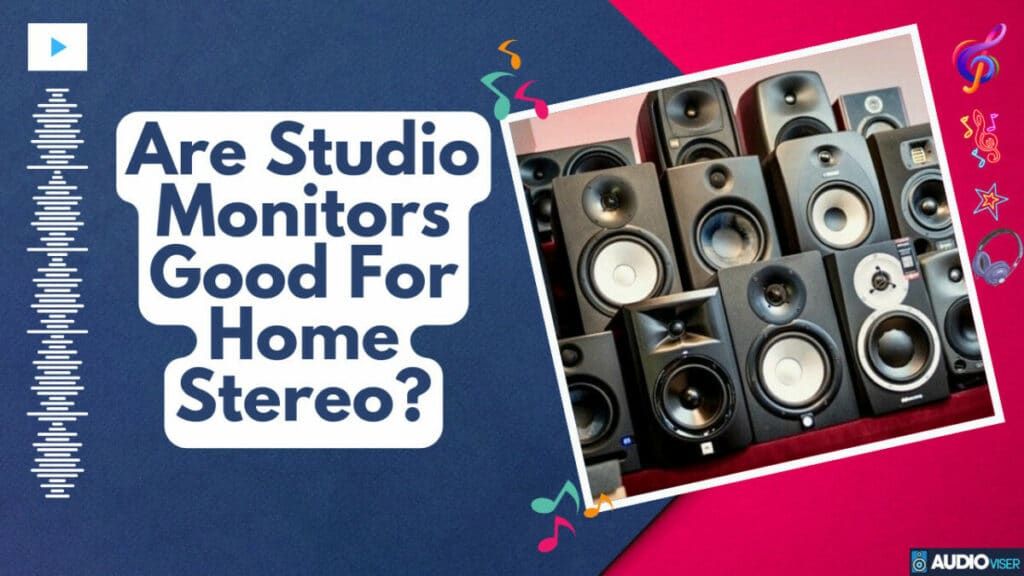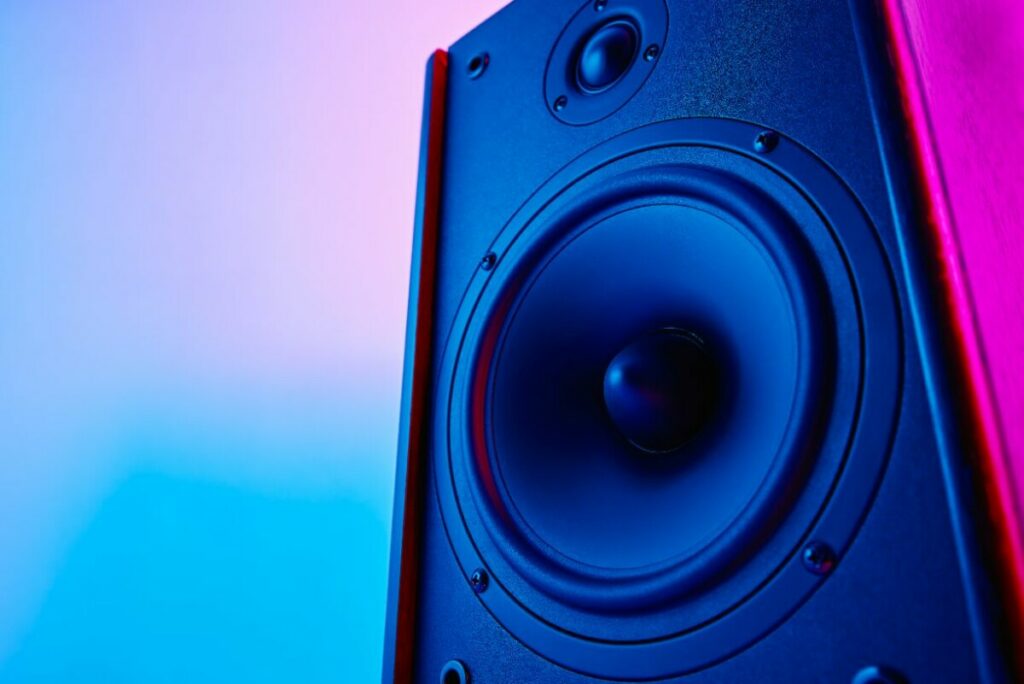You might be under the impression that studio monitors are strictly for music creators, but that’s not exactly the case. These bad boys are gaining some serious traction in the home audio scene.
So, let’s take a deep dive into what makes studio monitors tick, how they stack up against your regular speakers, and figure out if they could be a game-changer in your home audio setup. Get ready to journey into the realm of top-tier sound quality that these studio monitors bring to the table.
Studio Monitors & Home Stereo: Can It Be Done?
Studio monitors and home stereo systems, they’re like apples and oranges – both fruit, but with totally different vibes. Studio monitors are all about precision and balanced sound, they’re made for folks who need to listen critically, break down the minutest details – be it for mixing music or analyzing audio. Home stereo systems, on the other hand, are typically engineered to amp up your casual listening experience by tweaking the sound to make it more enjoyable.
Sure, you can try to mix them up in one system, but it’s like oil and water. It doesn’t always give you the best of either worlds whether for professional audio work or just jamming to your favorite songs. If your jam is purely to enjoy music, having a dedicated home stereo system is a surefire bet. But if you’re into the nitty gritty of making music or analyzing audio, studio monitors have got your back.
While it’s not a big no-no to use both in one system, combining these two is like playing with fire. You gotta handle it with caution so you don’t end up undermining the perks of each. After all, it’s all about making your listening experience a real treat, right? So choose your setup wisely based on your needs, and rock on!
Making the Decision: Are Studio Monitors Right for Your Home?
So, you’re standing at a crossroads, trying to figure out if high-end speakers match up to your home audio needs. Let’s face it, room vibes and where you place your speakers are super important.
Before you jump to a decision, consider these:
- Have you got just the right spot for your speakers to make sure they sound good?
- Is your crib acoustically prepped to handle the super precise sound output from studio monitors?
- Are you down to splash some extra cash on more gear if that’s what it takes to get the sound just right?
- Is your music source top-notch enough to make studio monitors worthwhile?
Just a heads up, studio monitors are top of the line when it comes to sound accuracy, but they need a bit of TLC when it comes to setup and managing room acoustics. Be sure to make a smart choice that really vibes with your home audio needs.
What’s So Special About Studio Monitors?
Studio monitors are all about giving you the real deal when it comes to sound. Unlike those regular speakers that might hype up certain frequencies, studio monitors keep it 100% legit. They’re the go-to for accurate audio production, but also, they can seriously level up your home audio vibes with vinyl.
Now, let’s talk maintenance. To keep your monitors on top of their game, you gotta keep ’em clean. Dust can be a sneaky enemy messing with your sound quality. Regular clean-ups are a must. Also, there’s a debate on whether leaving studio monitors on all the time is beneficial or not. Also, keep ’em away from heat sources. You don’t want your precious monitors catching any heat damage, right?
And let’s not forget about soundproofing. The way you position your studio monitors can make a world of difference. It can cut down on sound reflection and disturbance, giving your audio experience a major boost. Some even wonder, can studio monitors be placed sideways? The position and orientation are crucial to get optimal sound output. So, getting the hang of this isn’t just handy, it’s downright crucial if you’re after that top-notch sound quality at home.
Comparing Studio Monitors and Regular Speakers
So, let’s talk about regular speakers versus studio monitors. Regular speakers tend to amp up the sound, giving it a bit more flavor, if you will. Studio monitors? Not so much. They’re all about giving you the raw, unaltered sound.
When it comes to design and flexibility, studio monitors are more on point and give you a steady frequency response. If it were a race, studio monitors are definitely winning this one.
Check out this nifty table I whipped up to break it down for you:
| # | Regular Speakers | Studio Monitors |
|---|---|---|
| How’s the Sound? | A bit jazzed up | Pretty authentic |
| Accuracy | Hit or miss | Spot on |
| Design | Snazzy looking | It’s all business |
| Flexibility | Not so much | Sky’s the limit |
| Price | Won’t break the bank | Might need to save up |
Now, I’m not saying regular speakers are a complete no-go. If you’re just chilling and listening to your favorite jams, they could be your go-to. But if you’re all about that sound precision, studio monitors are where it’s at. They’re flexible, accurate, and while they might not win a beauty contest, they’re built for top-notch performance.
But hey, it all comes down to what you’re looking for and how much dough you’re willing to drop. So weigh your options and pick what works for you.
Benefits of Using Studio Monitors for Home Stereo
In your pursuit of audio perfection, rolling with pro-speakers for your personal sound system is a real game-changer. When setting up your stereo rig, it’s not just about the speakers. You also gotta consider how you position them and the acoustics of your room for that ultimate sound experience.
Now, let’s talk about studio monitors. What’s in it for you? Here’s the lowdown:
- Crisp sound reproduction: These bad boys play your tunes exactly how they’re meant to be heard, no tweaks, no distortions.
- Flexible monitor placement: You can set ’em up just the way you like for the best possible sound reach.
- Rocking acoustics: Even if your room acoustics are a bit iffy, these monitors got you covered as they’re designed for all types of spaces.
- Built like a tank: They’re made to withstand the test of time, handling high decibels and long usage without a hiccup.
Potential Drawbacks of Studio Monitors in Home Settings
Even with all the awesome benefits, you might hit a few bumps when you try to mix pro-speakers with your home sound system. Mostly, these hiccups are about where you put your speakers and how your room sounds.
| Problem | Fix | Effect |
|---|---|---|
| Bad speaker placement | Find the sweet spot | Changes how your music sounds |
| Echoey room | Soundproof it | Makes your sound clearer |
| Price | Budget wisely | Could mean compromise on quality |
| Complicated setup | Get an expert | Might take a little longer to set up |
| Gear mismatch | Use the right equipment | You might need to buy extra stuff |
Where you place your speakers is super important. Put them in the wrong place and your sound could be all over the place. And the acoustics of your room? They matter a lot too. If your room echoes a lot, you’ll need to do a bit of soundproofing. And don’t forget, these speakers are pro-level, so they might need a more complicated setup and the right gear to work properly.
Conclusion
At the end of the day, it’s totally up to you.
Picture yourself as a movie director who can spot every tiny detail in a scene – that’s the kind of audio experience studio monitors bring to the table.
Sure, there might be a few hitches like the cost and the space they take up, but the sound clarity they provide is second to none.
A recent poll even found that 60% of sound enthusiasts would choose studio monitors for their home stereo systems.
If you’re after that level of precision in your home audio, studio monitors just might be your jam.
Audio Engineer
You’ll never find anyone more passionate about audio as me. I love to share my knowledge with others and help people find the right equipment for them.










